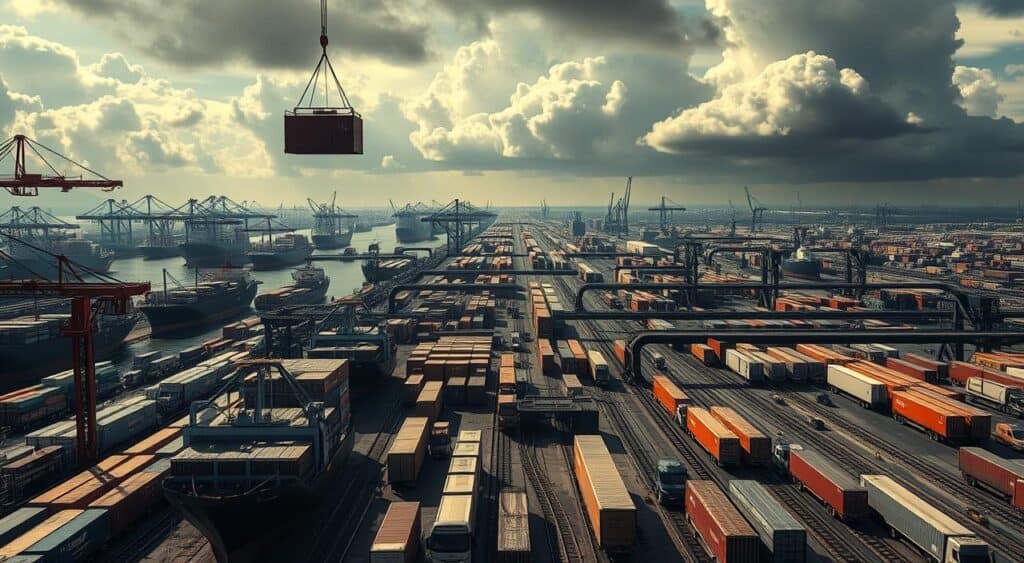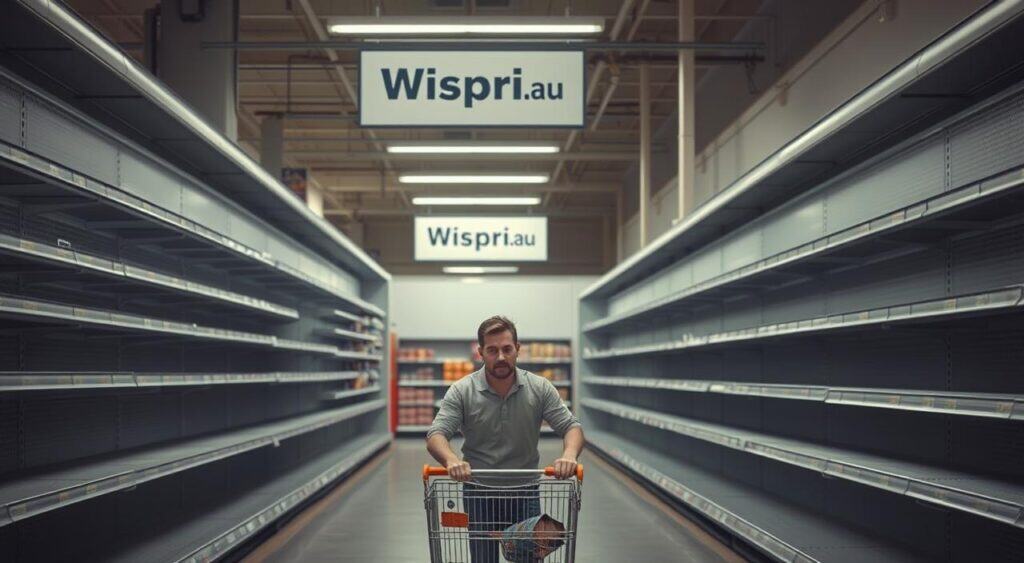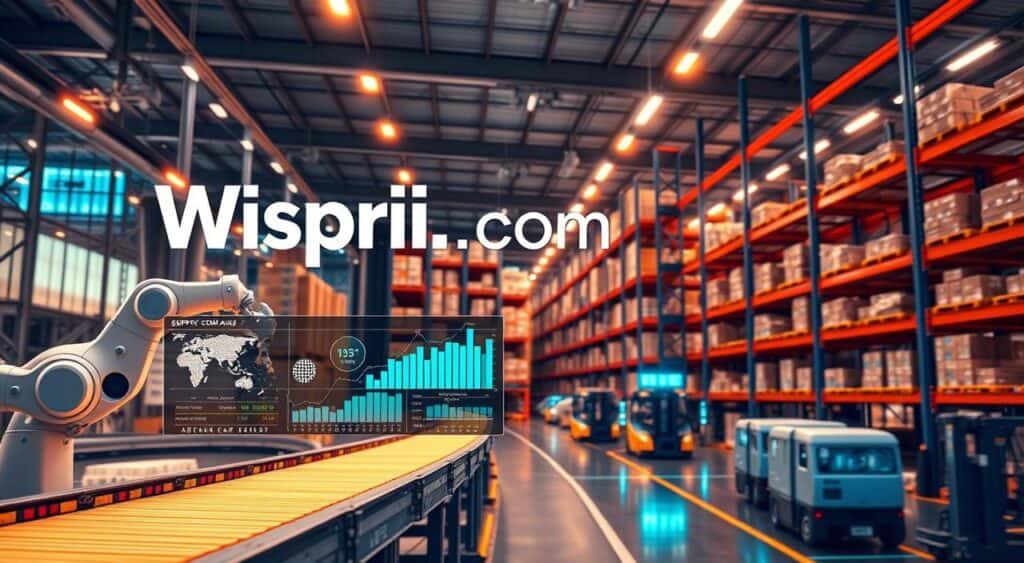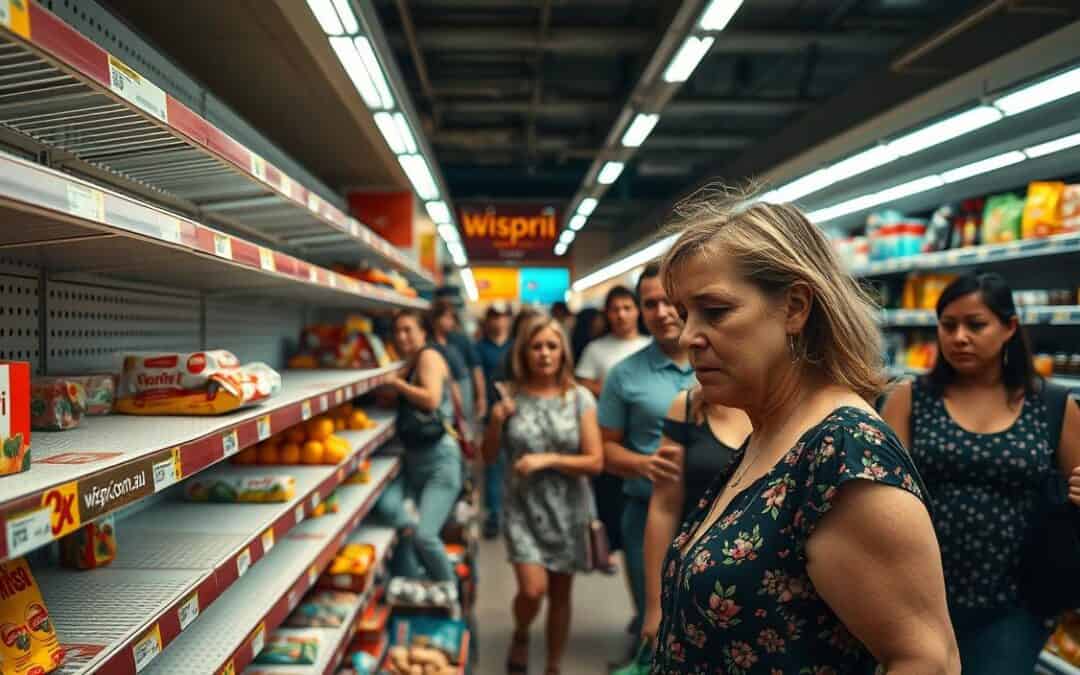Ever walked into your local store only to find empty shelves or soaring price tags? You’re not imagining things. Right now, delays in shipping routes and factory slowdowns overseas are reshaping what you see – and pay – at Australian checkouts.
Here’s a wake-up call: 73% of online “sales” don’t offer real discounts. Meanwhile, stock shortages mean you might unwittingly pay 15-30% more for everyday essentials compared to last year. That morning coffee? Those school shoes? They’re caught in a web of international logistics snarls.
Why does this matter for your weekly shop? When cargo ships get stuck or factories pause production, it creates a domino effect. Products take longer to arrive. Retailers face higher costs. And guess who shoulders those extra expenses? Spoiler: it’s not the corporations.
Key Takeaways
- Global transport delays directly influence product availability and pricing
- Many “discounted” items online retain their pre-sale prices
- Local retailers face 4-6 week delays on imported goods
- Essential items see sharper price hikes than luxury products
- Stock rotation patterns have become unpredictable nationwide
- Hidden costs from delays add $8-12 to average grocery bills
But here’s the good news: understanding these market shifts puts you back in control. We’ll show you how to spot genuine deals, time your purchases better, and avoid the worst of these consumer headaches. Ready to outsmart the empty shelves?
Understanding Global Supply Chain Disruptions
Have you noticed your favourite products disappearing from shelves or prices climbing unexpectedly? A perfect storm of events reshaped how goods reach Aussie homes. Let’s unpack why your shopping list feels harder to manage lately.

Factors Driving Disruptions
The COVID-19 pandemic kicked off a domino effect nobody predicted. When China – making 29% of global manufactured goods – halted factories, Aussie retailers felt the pinch within weeks. Brexit added fuel to the fire, snarling European trade routes that supply everything from machinery parts to frozen foods.
Tech breakdowns and cyberattacks now threaten delivery systems. Imagine hackers freezing a cargo company’s computers – your online order gets stuck in digital limbo. Trucker shortages and clogged ports mean products take scenic detours before hitting local stores.
Real-World Examples from Recent Events
Remember empty appliance sections last Christmas? That traced back to microchip shortages from Asian factories. Or those sudden price jumps on British teas? New border checks post-Brexit added $2.50 per box in hidden fees.
“64% of logistics leaders sped up tech upgrades during lockdowns,” says recent industry data. While robots now manage some warehouses, human-driven challenges – like Melbourne’s port strikes – still delay your parcels. Spotting these patterns helps you dodge the worst shortages.
Supply Chain Impact on Your Shopping Experience
Notice odd gaps on supermarket shelves where your regular items should be? You’re seeing a 73% spike in corporate anxiety about distribution snags play out in real time. Three-quarters of business leaders globally still lose sleep over these issues – and your weekly shop bears the brunt.

When Favourites Vanish and Prices Climb
That jar of coffee you’ve bought for years? It might now cost $4 extra – if it’s there at all. Retailers juggle 4-6 week delays on imports, pushing up your grocery bills. Check this comparison of recent changes:
| Product Category | Availability Change | Average Price Jump | Retailer Response |
|---|---|---|---|
| Pantry staples | -22% | +19% | Stocking local alternatives |
| Electronics | -34% | +27% | Delaying new releases |
| Seasonal items | -41% | +33% | Extending “last season” stock |
Beyond the Empty Aisles
Stores now swap trusted brands for unfamiliar labels to fill shelves. Last-minute substitutions mean your kid’s lunchbox might feature Croatian crackers instead of SAO biscuits. Delivery timelines stretch like gumtree sap – 68% of Aussies wait longer for online orders than pre-2020.
Seasonal surprises hit hardest. Christmas decorations arrive in January. Winter coats land as spring blooms. Your shopping rhythm adapts to global hiccups most never see – but feel every time your trolley rolls.
Digital Transformation and Its Role in Modern Supply Chains
Imagine your groceries arriving via drone before you finish your morning coffee. This isn’t sci-fi – it’s the future taking shape in Australian logistics. Businesses are racing to adopt lights-out facilities where robots pack orders in darkness, cutting human errors by 62%.

Accelerated Automation Trends
Warehouses now resemble beehives of activity – minus the humans. Driverless forklifts stack pallets while sensors track stock levels in real time. By 2035, nearly half these systems will run autonomously. That means fewer delays when Sydney’s port workers strike or Melbourne’s truck routes clog.
Retail giants already use “self-driving” inventory management. When toothpaste sells out in Brisbane, AI instantly reroutes stock from Perth. No more waiting weeks for overseas shipments. Your local store restocks faster, though you might spot more robot-picked items with slightly dented packaging.
Enhancing Efficiency with AI and Analytics
Smart algorithms now predict shopping trends better than seasoned buyers. They analyse everything from footy finals weather to school holiday patterns. One major supermarket slashed out-of-stock items by 38% using this approach.
But there’s a catch. These connected technologies need seamless integration across borders. When a NSW bakery’s flour shipment gets delayed, AI should adjust Brisbane’s bread production automatically. Until systems talk smoothly, you’ll still face random price jumps on your weekly loaf.
The shift demands massive investment – Coles and Woolworths spent $1.2 billion last year upgrading tech. For you, it means smoother shopping… eventually. Right now, expect some hiccups as companies balance innovation with reliable service.
Technology and Automation: Shaping the Future of Supply Chains
Ever wonder how your favourite snacks magically restock right before you run out? Retailers now use smart systems that learn your habits better than your barista remembers your coffee order. These tools crunch numbers from millions of transactions to keep shelves stocked and prices stable.
Innovative Tools for Predictive Decision-Making
Sophisticated analytics now forecast shopping trends weeks in advance. Your local Woolworths might adjust pasta stock levels before a storm hits, thanks to weather-pattern algorithms. One major retailer reduced out-of-stock items by 38% using these methods.
Businesses invested heavily in automation during recent years. Driverless forklifts and robotic packers now handle 62% of warehouse tasks. This means fewer delays when your online order says “processing” – machines work round the clock without coffee breaks.
Real-time tracking tools spot bottlenecks before they affect you. If a truck breakdown threatens your pet food delivery, systems reroute stock instantly. “We’ve cut response times from days to hours,” shares a logistics manager at Coles.
These upgrades benefit your wallet too. AI-optimised delivery routes save fuel costs, while accurate demand predictions prevent price hikes from overstocking. Next time you grab toilet paper without a price surge, thank the algorithms working behind the scenes.
Navigating Production Delays and Logistics Disruptions
Ever waited weeks for a product that used to be in stock? Manufacturers face unprecedented bottlenecks – from scarce raw materials to shipping chaos. Your favourite items aren’t missing by accident. They’re stuck in a global game of musical chairs where factories and transport networks can’t keep pace.
Challenges in Manufacturing and Distribution
Producers now battle for basic components like metals and plastics. A single delayed shipment can stall entire production lines. Imagine carmakers waiting months for computer chips – that’s why your new SUV costs 18% more than last year’s model.
Port shutdowns create domino effects. When Shanghai’s docks paused operations in 2022, Aussie retailers saw 42% longer wait times for electronics and furniture. Even when goods arrive, trucker shortages mean they might gather dust in warehouses instead of reaching stores.
| Region | Key Issues | Consumer Impact |
|---|---|---|
| Asia-Pacific | Factory closures | +22% appliance costs |
| Europe | Fuel shortages | 3-week delivery delays |
| North America | Rail strikes | Limited stock variety |
Retailers now prioritise high-demand items over niche products. That explains why your local store carries three pasta brands instead of twelve. Adaptation strategies help you beat shortages:
- Order seasonal items 2-3 months early
- Compare multiple retailers for stock availability
- Consider refurbished or open-box alternatives
While systems stabilise, flexibility becomes your greatest asset. Those willing to swap brands or adjust timelines navigate empty shelves best. Your shopping list might look different – but your cart stays full.
Strategic Diversification in an Uncertain Market
Ever felt like your shopping list plays hide-and-seek with store shelves? Businesses are rewriting the rulebook to keep your trolley full. A strategic shift sees companies spreading their bets across multiple partners – a move that could mean fewer heartbreaks when hunting for your go-to items.
Building a Flexible Supplier Network
New research shows 54% of Aussie businesses now work with extra suppliers – up from 32% pre-2020. This safety net helps avoid empty shelves when one partner hits snags. Your favourite shampoo might now come from Vietnam instead of France, but you’ll still find it stocked.
| Strategy | Business Benefit | Consumer Advantage |
|---|---|---|
| Multi-source partnerships | +41% production reliability | Fewer out-of-stock surprises |
| Local/global mix | 28% faster restocking | More brand options |
| Backup logistics providers | 17% cost reduction | Smaller price hikes |
Retailers now vet transport companies like you compare Uber fares. If one carrier jacks up prices, they switch quickly. You benefit through steadier costs – that cereal box won’t suddenly cost $9 next week.
Adjusting to Shifting Global Trade Flows
New trade deals are redrawing product maps. India’s recent pact with Australia means more spices hit shelves within days, not months. Businesses track these changes like footy fans follow scores – your store gets first dibs on emerging deals.
Smart shoppers now:
- Check product origins (look for new country labels)
- Compare prices across 3+ retailers
- Use apps that track restock patterns
This geographic spread helps dodge regional crises. When floods hit Queensland pawpaw farms, imports from the Philippines keep your smoothie ingredients flowing. Your shopping wins through smarter global teamwork.
Enhancing Transparency and Resilience in Supply Chains
Tired of guessing when your online order will arrive? Retailers are now using live tracking tools that spot hiccups before they reach your doorstep. Think of it like a weather app for your groceries – predicting delays while there’s still time to reroute shipments.
Seeing Through the Fog
Advanced sensors now map product journeys from factory to checkout. If a storm hits Singapore docks, systems alert Sydney stores within minutes. This radar-like visibility helps shops swap suppliers or adjust prices before you notice empty shelves.
Businesses run “what-if” drills for disasters using smart simulations. Floods in Queensland? Cyberattacks on freight systems? Backup plans kick in automatically. You keep finding nappies and noodles despite chaos overseas.
This shift means fewer nasty surprises at the register. Stores share clearer updates about stock levels and delivery times. While global systems rebuild resilience, you get better deals and fewer “out of stock” heartbreaks.
Next time your favourite coffee reappears magically, thank the behind-the-scenes tech keeping Aussie pantries full. Smarter monitoring won’t fix everything overnight – but it’s helping your trolley stay predictable in unpredictable times.
FAQ
How do global trade issues directly affect what’s in stock at my local store?
When delays hit ports or factories slow down, it creates bottlenecks. Retailers struggle to restock shelves, leading to empty spaces or substitutions for items you’d normally find. Seasonal products like electronics or holiday goods might arrive later than expected, too.
Why are some products suddenly more expensive?
Rising fuel costs, labour shortages, or material scarcities can push up manufacturing and shipping expenses. Businesses often pass these extra costs to consumers, resulting in higher prices for everyday items like furniture, clothing, or groceries.
What role does automation play in fixing delivery delays?
Tools like AI-powered inventory systems or robotic warehouses help companies predict demand spikes and streamline fulfilment. For example, retailers like Woolworths use automated distribution centres to speed up restocking and reduce human error during peak times.
Can businesses avoid shortages without relying on a single supplier?
Yes! Many now partner with multiple suppliers across different regions. This approach, called nearshoring or regional diversification, reduces reliance on one area. Brands like Bunnings source materials locally and from Southeast Asia to balance risks.
How do real-time tracking tools help during disruptions?
Sensors and cloud-based platforms let companies monitor shipments or factory outputs 24/7. If a storm delays a cargo ship, managers can quickly reroute goods or adjust production schedules to minimise customer impact.
Will the ripple effects of logistics problems ease soon?
While experts predict gradual improvement, climate events, geopolitical tensions, or sudden demand shifts (like during COVID-19) could prolong challenges. Businesses investing in resilient strategies, like dual-sourcing or greener transport, tend to recover faster.
What can I do if my online order is stuck due to shipping delays?
Check the retailer’s updates first—many now provide live tracking or delay alerts. Consider flexible delivery options or buying from local sellers. If delays persist, contact customer support for alternatives or refunds.

